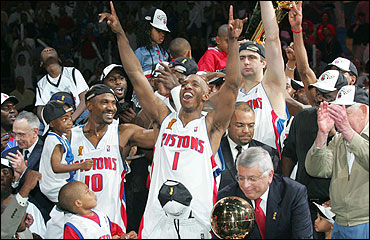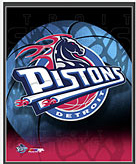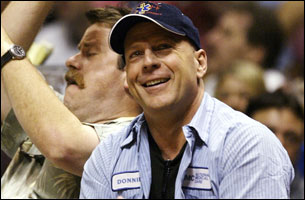‘Under God’
Michael Newdow is right. Atheists are outsiders in America.
BY SAMUEL P. HUNTINGTON
Wall Street Journal OnlineWednesday, June 16, 2004
The battle over the Pledge of Allegiance has stimulated vigorous controversy on an issue central to America’s identity. Opponents of “under God” (which was added to the pledge in 1954) argue that the United States is a secular country, that the First Amendment prohibits rhetorical or material state support for religion, and that people should be able to pledge allegiance to their country without implicitly also affirming a belief in God. Supporters point out that the phrase is perfectly consonant with the views of the framers of the Constitution, that Lincoln had used these words in the Gettysburg Address, and that the Supreme Court–which on Monday sidestepped a challenge to the Pledge of Allegiance–has long held that no one could be compelled to say the pledge.
The atheist who brought the court challenge, Michael Newdow, asked this question: “Why should I be made to feel like an outsider?” Earlier, the Court of Appeals in San Francisco had agreed that the words “under God” sent “a message to unbelievers that they are outsiders, not full members of the political community.”
Although the Supreme Court did not address the question directly, Mr. Newdow got it right: Atheists are “outsiders” in the American community. Americans are one of the most religious people in the world, particularly compared with the peoples of other highly industrialized democracies. But they nonetheless tolerate and respect the rights of atheists and nonbelievers. Unbelievers do not have to recite the pledge, or engage in any religiously tainted practice of which they disapprove. They also, however, do not have the right to impose their atheism on all those Americans whose beliefs now and historically have defined America as a religious nation.
Statistics say America is not only a religious nation but also a Christian one. Up to 85% of Americans identify themselves as Christians. Brian Cronin, who litigated against a cross on public land in Boise, Idaho, complained, “For Buddhists, Jews, Muslims and other non-Christians in Boise, the cross only drives home the point that they are strangers in a strange land.” Like Mr. Newdow and the Ninth Circuit judges, Mr. Cronin was on target. America is a predominantly Christian nation with a secular government. Non-Christians may legitimately see themselves as strangers because they or their ancestors moved to this “strange land” founded and peopled by Christians–even as Christians become strangers by moving to Israel, India, Thailand or Morocco.
Americans have always been extremely religious and overwhelmingly Christian. The 17th-century settlers founded their communities in America in large part for religious reasons. Eighteenth-century Americans saw their Revolution in religious and largely biblical terms. The Revolution reflected their “covenant with God” and was a war between “God’s elect” and the British “Antichrist.” Jefferson, Paine and other deists and nonbelievers felt it necessary to invoke religion to justify the Revolution. The Declaration of Independence appealed to “Nature’s God,” the “Creator,” “the Supreme Judge of the World,” and “divine Providence” for approval, legitimacy and protection.
The Constitution includes no such references. Yet its framers firmly believed that the republican government they were creating could last only if it was rooted in morality and religion. “A Republic can only be supported by pure religion or austere morals,” John Adams said. Washington agreed: “Reason and experience both forbid us to expect that national morality can prevail in exclusion of religious principles.” Fifty years after the Constitution was adopted, Tocqueville reported that all Americans held religion “to be indispensable to the maintenance of republican institutions.”
The words “separation of church and state” do not appear in the Constitution, and some people cite the absence of religious language in the Constitution and the provisions of the First Amendment as evidence that America is fundamentally secular. Nothing could be further from the truth. At the end of the 18th century, religious establishments existed throughout Europe and in several American states. Control of the church was a key element of state power, and the established church, in turn, provided legitimacy to the state. The framers of the Constitution prohibited an established national church in order to limit the power of government and to protect and strengthen religion. The purpose of “separation of church and state,” as William McLoughlin has said, was not to establish freedom from religion but to establish freedom for religion. As a result, Americans have been unique among peoples in the diversity of sects, denominations and religious movements to which they have given birth, almost all embodying some form of Protestantism. When substantial numbers of Catholic immigrants arrived, it was eventually possible to accept Catholicism as one more denomination within the broad framework of Christianity. The proportion of the population who were “religious adherents,” that is church members, increased fairly steadily through most of American history.
Today, overwhelming majorities of Americans affirm religious beliefs. When asked in 2003 simply whether they believed in God or not, 92% said yes. In a series of 2002-03 polls, 57% to 65% of Americans said religion was very important in their lives, 23% to 27% said fairly important, and 12% to 18% said not very important. Large proportions of Americans also appear to be active in the practice of their religion. In 2002 and 2003, an average of 65% claimed membership in a church or synagogue. About 40% said they had attended church or synagogue in the previous seven days, and roughly 33% said they went to church at least once a week. In the same period, about 60% of Americans said they prayed one or more times a day, more than 20% once or more a week, about 10% less than once a week, and 10% never. Given human nature, these claims of religious practice may be overstated, but the extent to which Americans believe the right response is to affirm their religiosity is itself evidence for the centrality of religious norms in American society.
Only about 10% of Americans, however, espouse atheism, and most Americans do not approve of it. Although the willingness of Americans to vote for a presidential candidate from a minority group has increased dramatically–over 90% of those polled in 1999 said they would vote for a black, Jewish or female presidential candidate, while 59% were willing to vote for a homosexual–only 49% were willing to vote for an atheist. Americans seem to agree with the Founding Fathers that their republican government requires a religious base, and hence find it difficult to accept the explicit rejection of God.
These high levels of religiosity would be less significant if they were the norm for other countries. Americans differ dramatically, however, in their religiosity from the people of other economically developed countries. This religiosity is conclusively revealed in cross-national surveys. In general, the level of religious commitment of countries varies inversely with their level of economic development: People in poor countries are highly religious; those in rich countries are not. America is the glaring exception. One analysis found that if America were like most other countries at her level of economic development, only 5% of Americans would think religion very important, but in fact 51% do.
An International Social Survey Program questionnaire in 1991 asked people in 17 countries seven questions concerning their belief in God, life after death, heaven and other religious concepts. Reporting the results, George Bishop ranked the countries according to the percentage of their population that affirmed these religious beliefs. The U.S. was far ahead in its overall level of religiosity, ranking first on four questions, second on one, and third on two, for an average ranking of 1.7. According to this poll, Americans are more deeply religious than even the people of countries like Ireland and Poland, where religion has been the core of national identity differentiating them from their traditional British, German and Russian antagonists.
Along with their general religiosity, the Christianity of Americans has impressed foreign observers and been affirmed by Americans. “We are a Christian people,” the Supreme Court declared in 1811. In the midst of the Civil War, Lincoln also described Americans as “a Christian people.” In 1892 the Supreme Court again declared, “This is a Christian nation.” In 1917 Congress passed legislation declaring a day of prayer in support of the war effort and invoking America’s status as a Christian nation. In 1931 the Supreme Court reaffirmed its earlier view: “We are a Christian people, according to one another the equal right of religious freedom, and acknowledging with reverence the duty of obedience to the will of God.”
While the balance between Protestants and Catholics shifted over the years, the proportion of Americans identifying themselves as Christian has remained relatively constant. In three surveys between 1989 and 1996, 84% to 88% of Americans said they were Christians. The proportion of Christians in America rivals or exceeds the proportion of Jews in Israel, of Muslims in Egypt, of Hindus in India, and of Orthodox believers in Russia.
America’s Christian identity has, nonetheless, been questioned on two grounds. It is argued, first, that America is losing that identity because non-Christian religions are expanding in numbers, and Americans are thus becoming a multireligious and not simply a multidenominational people; second, that Americans are losing their religious identity and are becoming secular, atheistic, materialistic and indifferent to their religious heritage. Neither of these propositions comes close to the truth.
The argument that America is losing its Christian identity due to the spread of non-Christian religions was advanced by several scholars in the 1980s and ’90s. They pointed to the growing numbers of Muslims, Sikhs, Hindus and Buddhists in American society. Hindus increased from 70,000 in 1977 to 800,000 in 1997. Muslims amounted to at least 3.5 million in 1997, while Buddhists numbered somewhere between 750,000 and two million. From these developments, the proponents of de-Christianization argue, in the words of Prof. Diana Eck, that “religious diversity” has “shattered the paradigm of America” as an overwhelmingly Christian country with a small Jewish minority.
The increases in the membership of some non-Christian religions have not, to put it mildly, had any significant effect on America’s Christian identity. As a result of assimilation, low birth rates, and intermarriage, the proportion of Jews dropped from 4% in the 1920s to 3% in the ’50s to slightly over 2% in 1997. If the absolute numbers claimed by their spokesmen are correct, by 1997 about 1.5% of Americans were Muslim, while Hindus and Buddhists were each less than 1%. The numbers of non-Christian, non-Jewish believers undoubtedly will continue to grow, but for years to come they will remain extremely small. Some increases in the membership of non-Christian religions come from conversions, but the largest share is from immigration and high birthrates. The immigrants of these religions, however, are far outnumbered by immigrants from Latin America, almost all of whom are Catholic and also have high birthrates. Latin American immigrants are also converting to evangelical Protestantism. In addition, Christians in Asia and the Middle East have been more likely than non-Christians to migrate to America. As of 1990, a majority of Asian-Americans were Christian rather than Buddhist or Hindu, and about two-thirds of Arab-Americans have been Christian rather than Muslim, although Arab Muslim immigrants have become much more numerous. While a precise judgment is impossible, at the start of the 21st century the U.S. was probably becoming more rather than less Christian in its religious composition.
Americans tend to have a certain catholicity toward religion: All deserve respect. Given this general tolerance of religious diversity, non-Christian faiths have little alternative but to recognize and accept America as a Christian society. “Americans have always thought of themselves as a Christian nation,” argues Jewish neoconservative Irving Kristol, “equally tolerant of all religions so long as they were congruent with traditional Judeo-Christian morality. But equal toleration . . . never meant perfect equality of status in fact.” Christianity is not legally established, “but it is established informally, nevertheless.”
But if increases in non-Christian membership haven’t diluted Christianity in America, hasn’t it been supplanted over time by a culture that is pervasively irreligious, if not antireligious? These terms describe segments of American intellectual, academic and media elites, but not the bulk of the American people. American religiosity could be high by absolute measures and high relative to that of comparable societies, yet the secularization thesis would still be valid if the commitment of Americans to religion declined over time. Little or no evidence exists of such a decline. The one significant shift that does appear to have occurred is a drop in the 1960s and ’70s in the religious commitment of Catholics. This shift, however, brought Catholic attitudes on religion more into congruence with those of Protestants.
Over the course of American history, fluctuations did occur in levels of American religious commitment and religious involvement. There has not, however, been an overall downward trend in American religiosity. At the start of the 21st century, Americans are no less committed, and are quite possibly more committed, to their religious beliefs and their Christian identity than at any time in their history.
Mr. Huntington, the Albert J. Weatherhead III University Professor at Harvard, is the author of “The Clash of Civilizations and the Remaking of the World Order” (Simon & Schuster, 1998). This is adapted from the current issue of The American Enterprise.



 Mr. Bill Davidson, the owner of international glass company
Mr. Bill Davidson, the owner of international glass company  I had a great time tonight at Game 6 of the Detroit Pistons-New Jersey Nets NBA Eastern Conference Semifinals series. I was the guest of Steve Cohen, one of the owners of the Nets Franchise (and a congregant of Cong. Agudath Israel in Caldwell, NJ). In addition to the dinner in the Franchise Room before the game, courtside seats, and spending half-time in the Owners’ Suite, I had the chance to meet Bruce Willis and the rapper Jay-Z after the game as they left via the Franchise Room entrance. But the best part of all can be summed up by the scoreboard:
I had a great time tonight at Game 6 of the Detroit Pistons-New Jersey Nets NBA Eastern Conference Semifinals series. I was the guest of Steve Cohen, one of the owners of the Nets Franchise (and a congregant of Cong. Agudath Israel in Caldwell, NJ). In addition to the dinner in the Franchise Room before the game, courtside seats, and spending half-time in the Owners’ Suite, I had the chance to meet Bruce Willis and the rapper Jay-Z after the game as they left via the Franchise Room entrance. But the best part of all can be summed up by the scoreboard: 